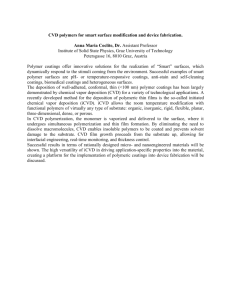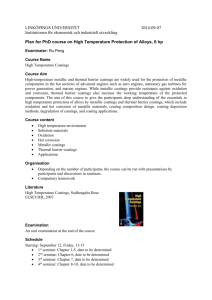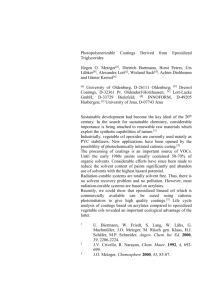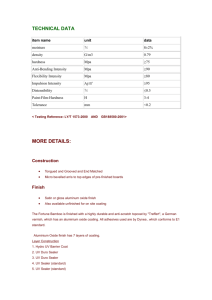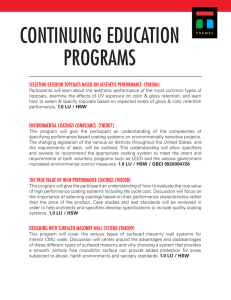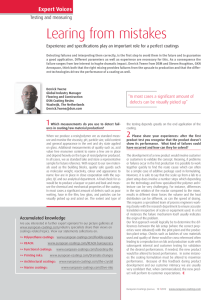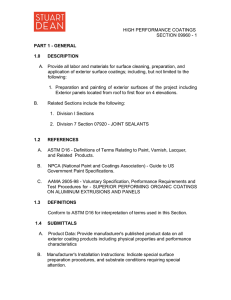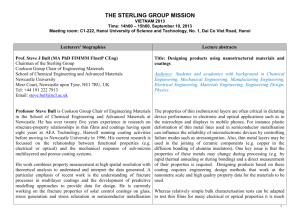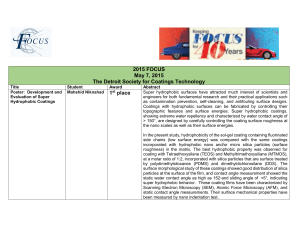Abstract summaries
advertisement
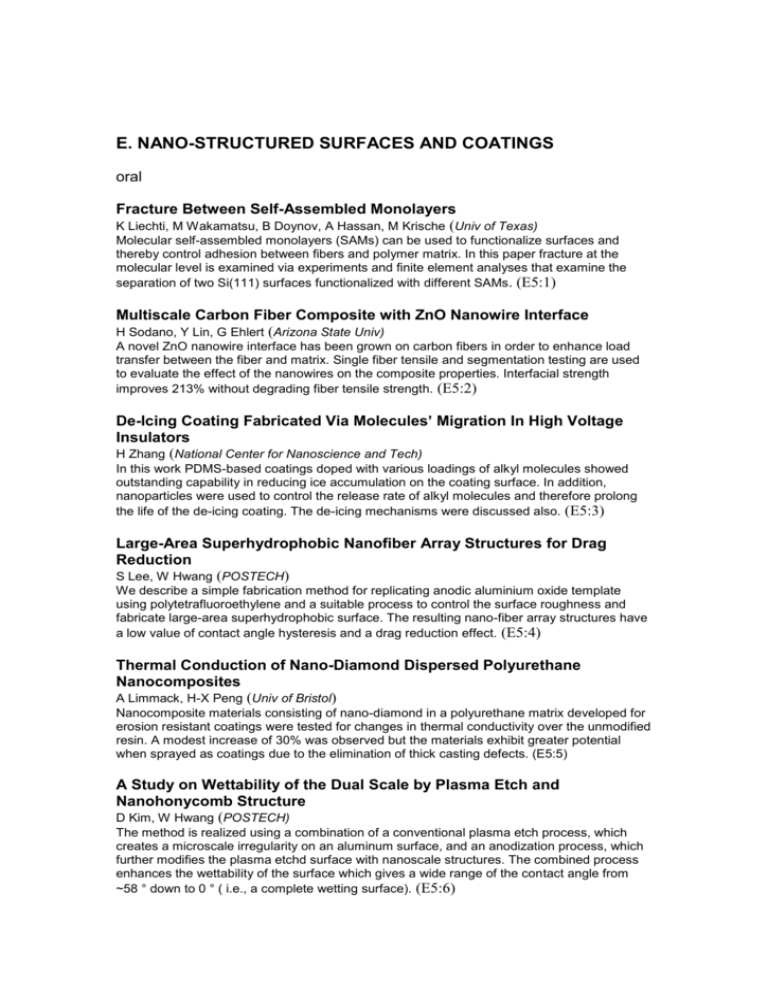
E. NANO-STRUCTURED SURFACES AND COATINGS oral Fracture Between Self-Assembled Monolayers K Liechti, M Wakamatsu, B Doynov, A Hassan, M Krische (Univ of Texas) Molecular self-assembled monolayers (SAMs) can be used to functionalize surfaces and thereby control adhesion between fibers and polymer matrix. In this paper fracture at the molecular level is examined via experiments and finite element analyses that examine the separation of two Si(111) surfaces functionalized with different SAMs . (E5:1) Multiscale Carbon Fiber Composite with ZnO Nanowire Interface H Sodano, Y Lin, G Ehlert (Arizona State Univ) A novel ZnO nanowire interface has been grown on carbon fibers in order to enhance load transfer between the fiber and matrix. Single fiber tensile and segmentation testing are used to evaluate the effect of the nanowires on the composite properties. Interfacial strength improves 213% without degrading fiber tensile strength. (E5:2) De-Icing Coating Fabricated Via Molecules’ Migration In High Voltage Insulators H Zhang (National Center for Nanoscience and Tech) In this work PDMS-based coatings doped with various loadings of alkyl molecules showed outstanding capability in reducing ice accumulation on the coating surface. In addition, nanoparticles were used to control the release rate of alkyl molecules and therefore prolong the life of the de-icing coating. The de-icing mechanisms were discussed also. (E5:3) Large-Area Superhydrophobic Nanofiber Array Structures for Drag Reduction S Lee, W Hwang (POSTECH) We describe a simple fabrication method for replicating anodic aluminium oxide template using polytetrafluoroethylene and a suitable process to control the surface roughness and fabricate large-area superhydrophobic surface. The resulting nano-fiber array structures have a low value of contact angle hysteresis and a drag reduction effect. (E5:4) Thermal Conduction of Nano-Diamond Dispersed Polyurethane Nanocomposites A Limmack, H-X Peng (Univ of Bristol) Nanocomposite materials consisting of nano-diamond in a polyurethane matrix developed for erosion resistant coatings were tested for changes in thermal conductivity over the unmodified resin. A modest increase of 30% was observed but the materials exhibit greater potential when sprayed as coatings due to the elimination of thick casting defects. (E5:5) A Study on Wettability of the Dual Scale by Plasma Etch and Nanohonycomb Structure D Kim, W Hwang (POSTECH) The method is realized using a combination of a conventional plasma etch process, which creates a microscale irregularity on an aluminum surface, and an anodization process, which further modifies the plasma etchd surface with nanoscale structures. The combined process enhances the wettability of the surface which gives a wide range of the contact angle from ~58 ° down to 0 ° ( i.e., a complete wetting surface). (E5:6) 16.10 E. NANO-STRUCTURED SURFACES AND COATINGS Transparent Wear-Resistant Acrylate-Based Coating with Highly Filled Nanosilica Particles Z Zhang, H Zhang, L Tang (Nat Center for Nanoscience & Tech) C Eger (nanoresins AG) A urethane-acrylate oligomer was mixed with varied concentrations of nanosilica particle sol, spin-coated onto polycarbonate substrate and finally cured by UV light. Super scratch resistance was achieved by the almost perfect dispersed nanoparticles. Wear performances were characterized by various approaches and wear mechanisms were discussed based on worn-surface observations. (E5:7) Polymer-Grafted Silica Nanoparticles for Improving Mechanical Properties of Coatings and Resins G Jonschker, R Friedrich, J Schütz-Widoniak, J Pahnke (Merck KGaA) NEEDS 50 WORD ABSTRACT (E5:8) On the Way to Functional Coatings: Polyelectrolyte Multilayers E Guzmán-Solís, M Encinar-del Pozo, F Ortega, R González-Rubio (Univ Complutense de Madrid) M González-Prolongo (Univ Politécnica de Madrid) M Ángel Rubio (UNED) Multilayers formed by the alternate deposition of materials with opposite charge have a big interest for the building of functional coatings. The control of the building process and mechanical properties of this coating has a great importance for the future applications of these films. (E5:9) Synthsis of Oxides Surface with Ordered Macroporous Structures J-P Zhao, Y Li, W-H Xin (HIT) Yttria stabilized zirconia, gadolinia-doped ceria, niobium and tantalum oxides surfaces with interconnected macropores presenting well-defined pore sizes and controlled threedimensional ordering (3-DOM) were prepared using colloidal crystal templates of polystyrene spheres. The method reported here is simple, inexpensive and effective. These kinds of materials have potential applications in filtration, separation, catalyst supports, and photonics. (E5:10


